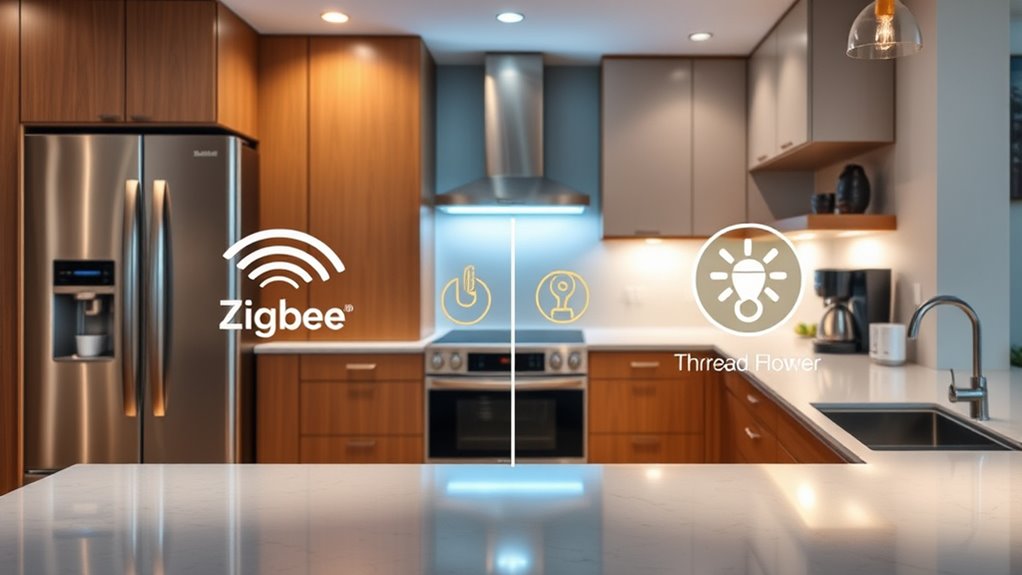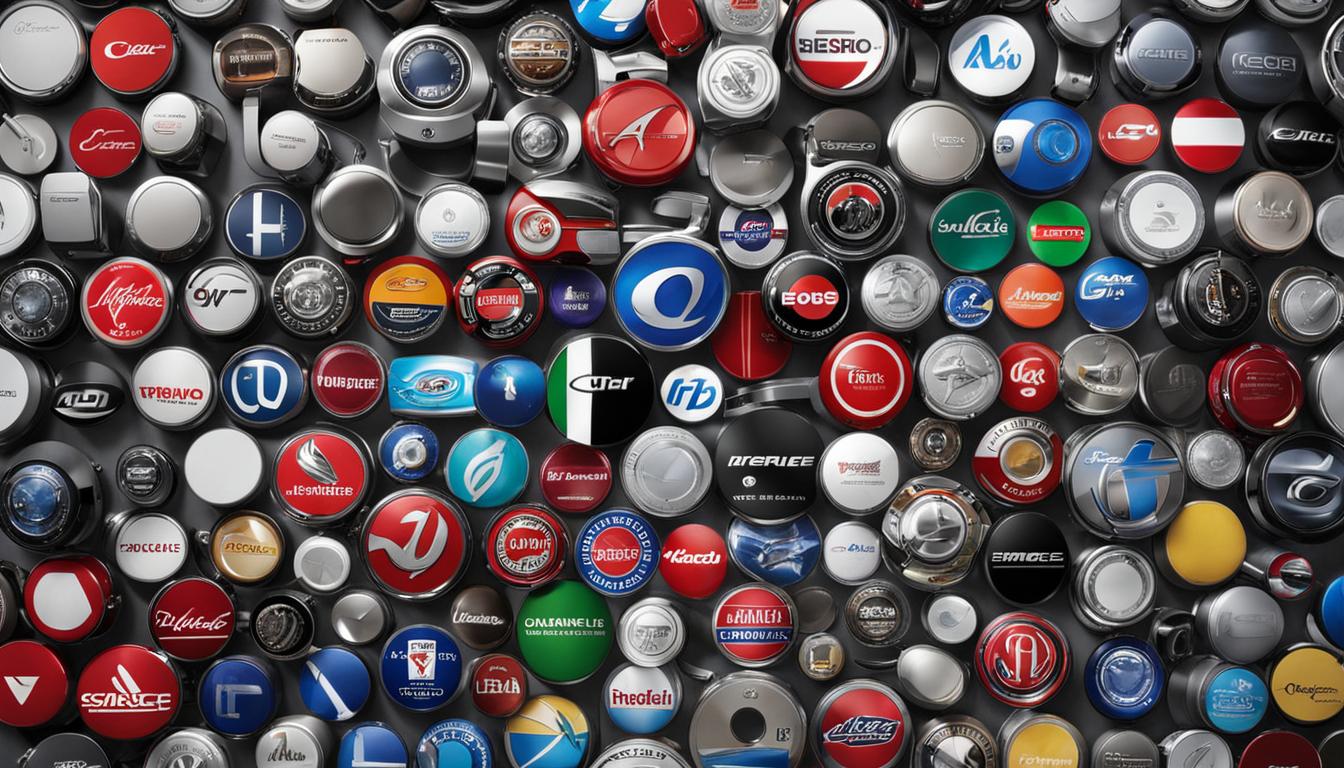Zigbee and Thread are both great for connected appliances, but they suit different needs. Zigbee offers broad device compatibility, a mature ecosystem, and is easier to set up, making it ideal for diverse smart home setups. Thread provides low latency, high security, and seamless internet integration, perfect for high-performance appliances. To choose the best one for your needs, consider your device ecosystem and connectivity goals—more details below can help you decide.
Key Takeaways
- Zigbee offers a mature ecosystem with broad device compatibility, while Thread provides IP-based connectivity for future-proof, secure communication.
- Both protocols support mesh networks, but Zigbee’s established ecosystem simplifies device integration and expansion.
- Thread enables direct internet access via IPv6, making it ideal for remote control and cloud integration of appliances.
- Zigbee is better suited for environments with diverse device ecosystems, whereas Thread excels in low-latency, high-performance appliance networks.
- Security features are strong in both, but Thread’s built-in IP security architecture offers enhanced protection for connected appliances.
Overview of Zigbee and Thread Technologies

Zigbee and Thread are two popular wireless protocols designed to connect smart home devices, but they differ markedly in their architecture and features. Zigbee operates on a mesh network using the IEEE 802.15.4 standard, allowing devices to communicate directly or through routers, which extends coverage. It supports a wide range of device types and has been around since 2002, with a large ecosystem. Thread, also based on IEEE 802.15.4, is a newer protocol focused on low-power, secure mesh networking for IoT devices. It emphasizes simplicity and robustness, with built-in IP support that enables seamless integration with existing internet infrastructure. Both protocols aim for reliable device communication, but their design philosophies and ecosystem maturity set them apart. Additionally, the ease of integration and support for different device ecosystems can influence the choice between Zigbee and Thread for specific smart home setups. Furthermore, Thread’s seamless internet compatibility facilitates easier expansion and interoperability within smart home networks. For example, Thread’s use of IPv6 addresses enhances compatibility with internet infrastructure, making it more future-proof.
Network Topology and Structure
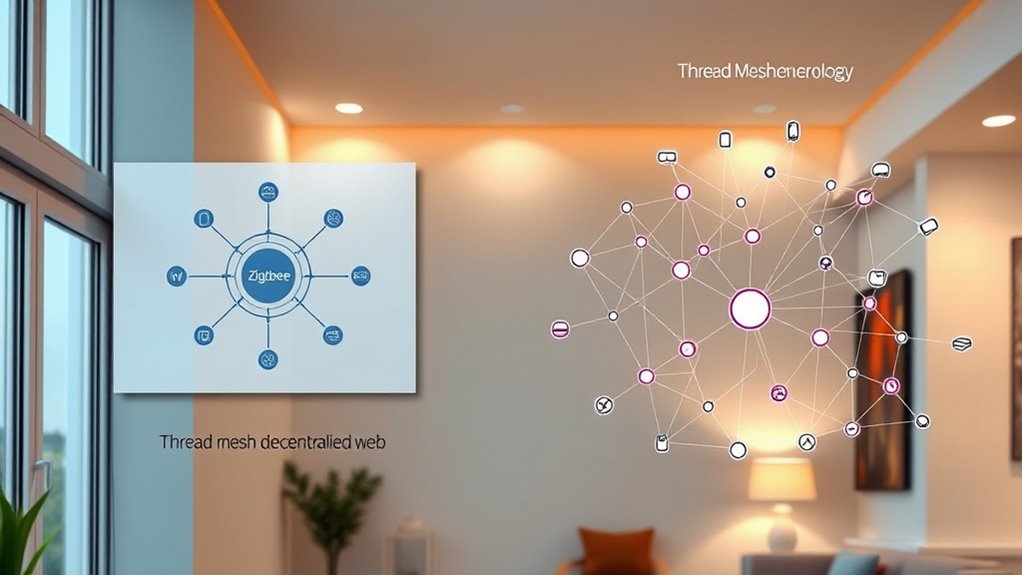
Your choice of network topology impacts how your appliances communicate and expand. Mesh networks offer greater flexibility and resilience, while star setups are simpler but less adaptable. Understanding node distribution and scalability helps you design a reliable, future-proof connected home. Additionally, selecting a network that supports secure log-in and data protection measures is essential for maintaining privacy and security in your smart environment. Implementing privacy policies that outline data collection and user rights further enhances trust and safety. Considering the integration of a variety of connected devices, including those used for home decor and security, can optimize your smart home ecosystem. Choosing a network that supports Gold IRA options can also provide a secure method for diversifying your investment portfolio through connected financial devices.
Mesh vs. Star
When choosing between mesh and star network topologies for connected appliances, understanding their fundamental differences is essential. A star topology connects each device directly to a central hub or coordinator, simplifying management but risking complete network failure if the hub goes down. It’s ideal for small setups with straightforward communication needs. In contrast, a mesh topology links devices directly to multiple other devices, creating a resilient network where data can take various paths. This enhances reliability and extends range but adds complexity and cost. Mesh networks are better suited for larger, more dynamic environments where continuous connectivity is critical. Additionally, understanding the technology differences between these topologies can help optimize network performance and network resilience. The fault tolerance of a mesh network makes it a robust choice for environments requiring uninterrupted connection, despite the increased complexity and cost. Furthermore, considering the network scalability is crucial for future growth and expansion. Incorporating self-healing capabilities can further improve network robustness by automatically rerouting data if a device fails, which is a common feature in mesh systems.
Node Distribution Flexibility
Node distribution flexibility plays a crucial role in determining how easily devices can be added, moved, or reconfigured within a network. With Zigbee, you benefit from a flexible mesh structure that allows devices to connect and re-route data dynamically. This makes expanding or reorganizing your network straightforward, even after initial setup. Thread also offers strong flexibility, supporting a mesh topology that enables devices to join or leave without disrupting the entire network. Its self-healing capabilities help maintain connectivity when nodes are moved or removed. Both protocols prioritize adaptability, but Zigbee’s longer-established ecosystem provides more mature tools for flexible node placement. Additionally, the variety of water parks in various locations highlight how different environments can accommodate flexible and adaptable infrastructure. Ultimately, your choice depends on your need for dynamic reconfiguration and how easily you want to manage device distribution in your connected environment.
Network Scalability
Network scalability is essential for ensuring your connected appliance system can grow seamlessly as more devices are added. Zigbee’s mesh topology allows devices to communicate directly with each other, creating a flexible network that easily expands. As you add new appliances, the mesh structure automatically reroutes data, maintaining performance. Thread also uses a mesh topology, enhancing scalability by supporting multiple routes for data transmission. It’s designed to handle large networks efficiently, making it ideal for expanding smart homes. Both protocols support network growth without significant reconfiguration, but Thread’s architecture offers better scalability for dense deployments. You’ll find that as your network expands, both Zigbee and Thread maintain reliable connectivity, ensuring your connected appliances work harmoniously even as the number of devices increases.
Power Consumption and Energy Efficiency

Your choice between Zigbee and Thread can markedly affect your device’s battery life and overall energy use. Both protocols offer different power-saving features that can extend device operation, but their efficiency varies. Understanding these differences helps you optimize connected appliances for longer-lasting performance. For instance, Thread incorporates low-power mesh networking techniques that enable devices to consume less energy during communication. Additionally, Thread’s support for sleep modes allows devices to enter low-energy states when not actively transmitting, further conserving power.
Battery Life Impact
When comparing Zigbee and Thread for connected appliances, their power consumption and energy efficiency play essential roles in battery life. Zigbee’s low-power design allows devices to sleep frequently, conserving energy and extending battery life considerably. Thread also emphasizes low power, using efficient protocols that minimize energy drain during communication. However, Thread’s mesh networking can sometimes lead to increased energy use if multiple devices relay data constantly. Your choice impacts how long your appliances can operate on a single battery charge. If you prioritize longer battery life with infrequent device activity, Zigbee’s sleep modes might be advantageous. Conversely, if your setup involves frequent communication, Thread’s energy-efficient routing can help preserve battery life while maintaining reliable connectivity. Ultimately, both technologies offer solid energy performance, but their specific use cases dictate which better supports your appliances’ battery needs. Additionally, the mesh networking capabilities of both protocols can influence overall energy consumption depending on network size and activity levels. A thorough understanding of power consumption factors can help optimize device longevity.
Network Energy Use
Both Zigbee and Thread are designed to optimize power consumption, but they approach energy efficiency differently. Zigbee uses a beacon-enabled protocol, allowing devices to sleep and wake periodically, reducing overall power use. It’s flexible, but this can sometimes lead to higher energy consumption if devices frequently wake. Thread, on the other hand, employs an IPv6-based mesh network with low-power radios that communicate efficiently, maintaining connections with minimal energy. Its design emphasizes continuous connectivity with low power overhead, making it well-suited for battery-powered devices. Overall, Thread tends to use less energy during network operation, especially in larger networks, due to its efficient routing and low-power standards. Both protocols aim to conserve energy, but Thread’s architecture generally offers better energy efficiency for connected appliances. Additionally, power management techniques in Thread-enabled devices further enhance their energy-saving capabilities.
Power Saving Features
Zigbee and Thread incorporate advanced power-saving features that directly impact overall energy consumption. These protocols optimize device sleep modes, reduce active radio time, and manage data transmission efficiently. Zigbee uses beaconing and low-duty cycles to conserve power, while Thread employs efficient mesh networking that minimizes power use during communication. Both protocols allow devices to stay in low-power sleep states when inactive, extending battery life. Here’s a quick comparison:
| Feature | Zigbee | Thread |
|---|---|---|
| Sleep Mode Efficiency | High, with beacon management | Very high, with low-duty cycle |
| Data Transmission | Scheduled, energy-conscious | Asynchronous, low power |
| Mesh Networking | Optimized for low power | Inherently energy-efficient |
These features help connected appliances operate longer on batteries, reducing energy costs and enhancing sustainability.
Security Features and Data Protection
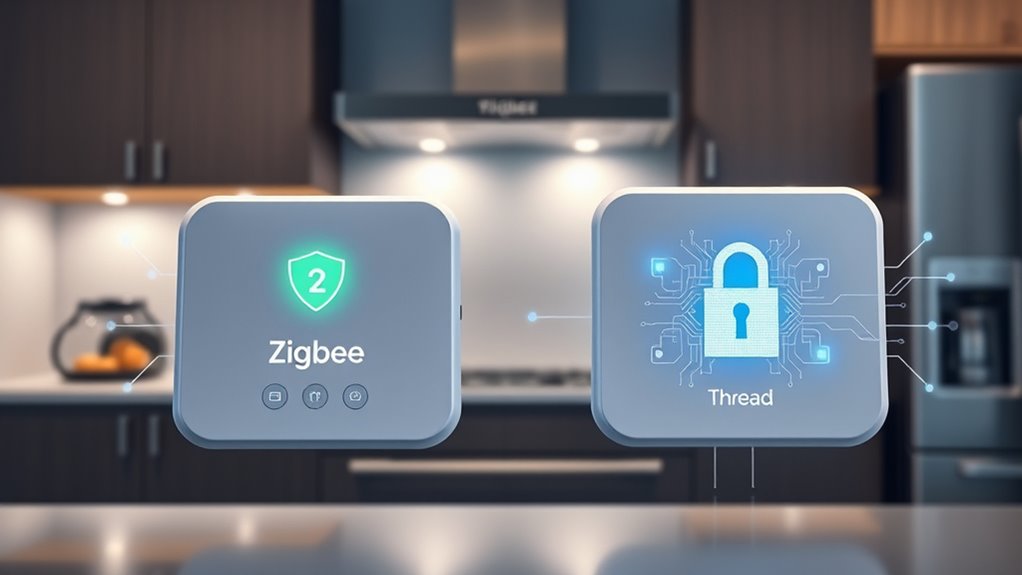
Security features and data protection are crucial considerations when choosing between Zigbee and Thread for connected appliances. Zigbee uses AES-128 encryption, ensuring data remains secure during transmission. It also supports network keys and device authentication, preventing unauthorized access. Thread, on the other hand, incorporates robust security by default. It employs AES-128 encryption, device attestation, and secure commissioning processes to protect your network. Thread’s security architecture is designed to be resilient against attacks, with a focus on maintaining privacy and integrity. Both protocols prioritize safeguarding your data, but Thread’s security measures are built into its core, offering a more seamless and extensive approach. Ultimately, your choice should depend on the level of security you need for your connected home.
Device Compatibility and Ecosystem Support
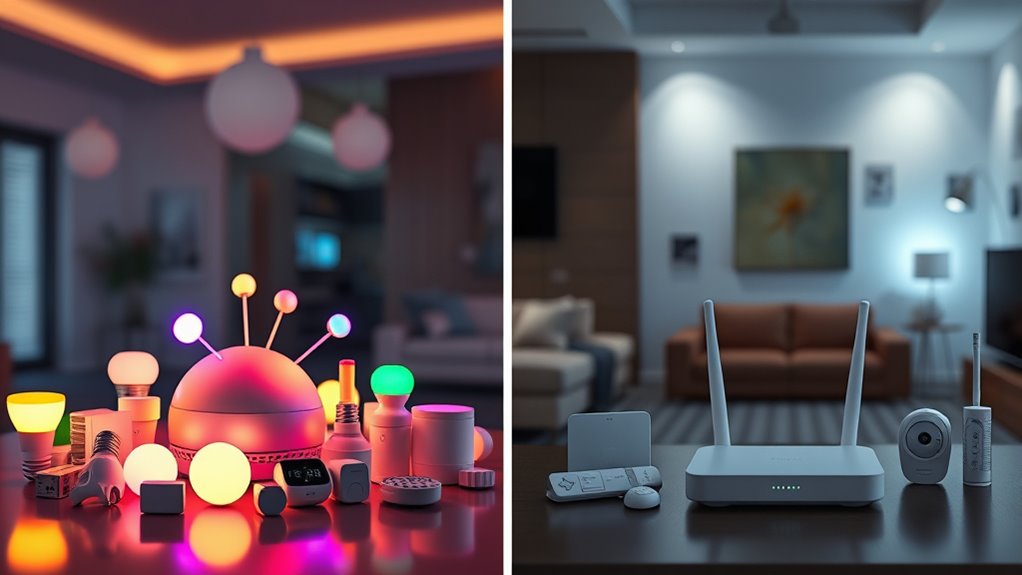
Device compatibility and ecosystem support play a pivotal role in determining how well your connected appliances will integrate and work together. With Zigbee, you’ll find a broad range of compatible devices from multiple manufacturers, making it easier to expand your smart home over time. Its established ecosystem includes popular brands and hubs, ensuring seamless integration. Thread, on the other hand, is newer but rapidly growing. It offers strong support for IP-based devices, which can simplify compatibility with existing Wi-Fi and Ethernet networks. However, Thread’s ecosystem is still developing, meaning fewer devices and hubs are available compared to Zigbee. Your choice depends on the devices you want and the ecosystem support you prefer, impacting long-term compatibility and ease of expanding your smart appliance network.
Ease of Deployment and Setup
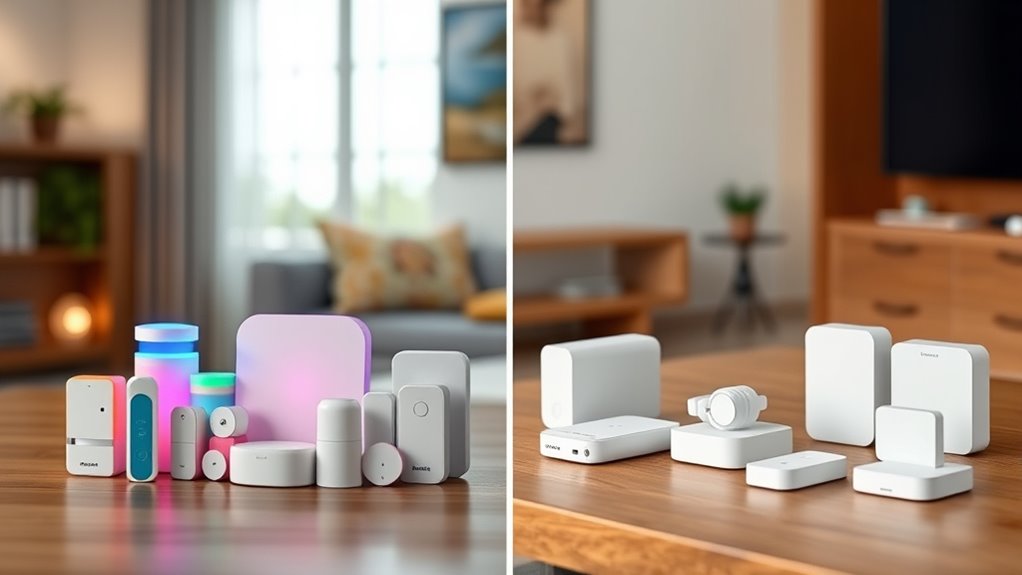
Setting up your connected appliances can be straightforward with Zigbee, thanks to its well-established and user-friendly process. You’ll find it easy to add devices to your network without technical expertise. Here are some reasons why:
Zigbee makes connecting appliances simple and hassle-free with easy pairing and clear instructions.
- Simple pairing: Zigbee devices often come with one-touch pairing, making setup quick and hassle-free.
- Universal compatibility: Most Zigbee products work with popular hubs, reducing the complexity of integration.
- Clear instructions: Manufacturers provide straightforward guides, helping you connect devices confidently.
- Minimal configuration: Once paired, Zigbee devices typically require little to no ongoing setup, saving time.
Scalability and Network Size Limitations

While Zigbee’s simple setup makes it accessible for users, its network scalability can pose challenges as you add more connected appliances. Zigbee networks typically support up to 65,000 devices, but practical limitations often occur earlier due to network congestion and interference, especially in dense environments. As you connect more devices, packet collisions and latency may increase, reducing overall performance. Additionally, Zigbee’s mesh topology relies on each device relaying signals, which can strain the network as it grows larger, potentially causing dropped connections. In contrast, Thread is designed for larger networks, supporting hundreds of devices with better scalability. It maintains performance by optimizing routing and reducing network congestion, making it more suitable for expanding smart home ecosystems.
Cost Considerations and Licensing
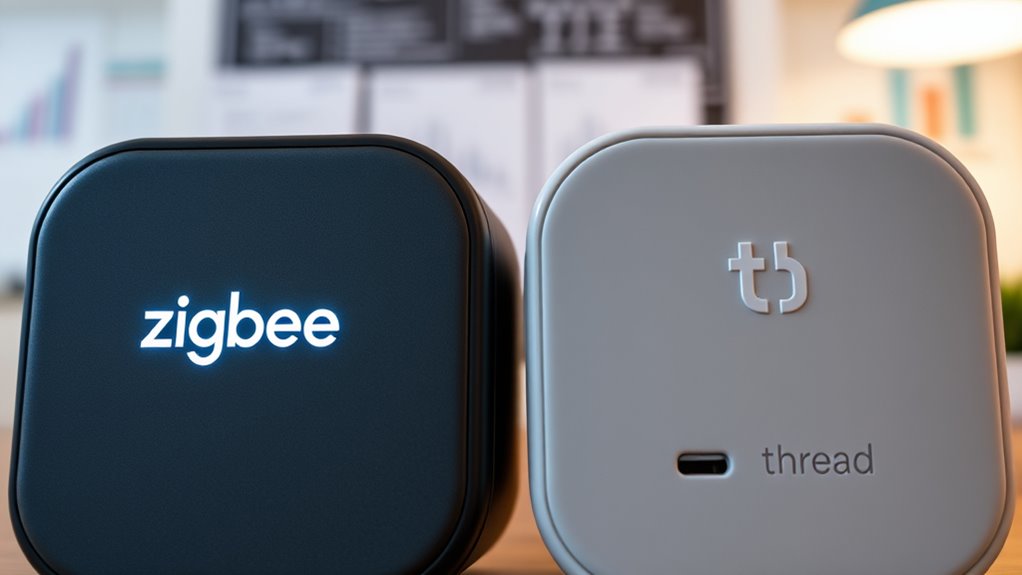
When choosing between Zigbee and Thread for your connected appliances, cost considerations and licensing fees play a significant role. Zigbee typically involves lower upfront costs since many devices are off-the-shelf and don’t require licensing fees. Thread, on the other hand, may have higher initial expenses due to its more advanced hardware requirements. Here are some key points to consider:
- Zigbee devices often have lower production costs, making them more budget-friendly.
- Licensing fees for Zigbee are generally minimal or nonexistent.
- Thread devices might require premium chips, increasing upfront investment.
- Long-term costs may favor Zigbee if you’re deploying many devices, due to its widespread adoption.
Ultimately, your budget and scale will influence which protocol makes more financial sense.
Use Cases and Ideal Applications
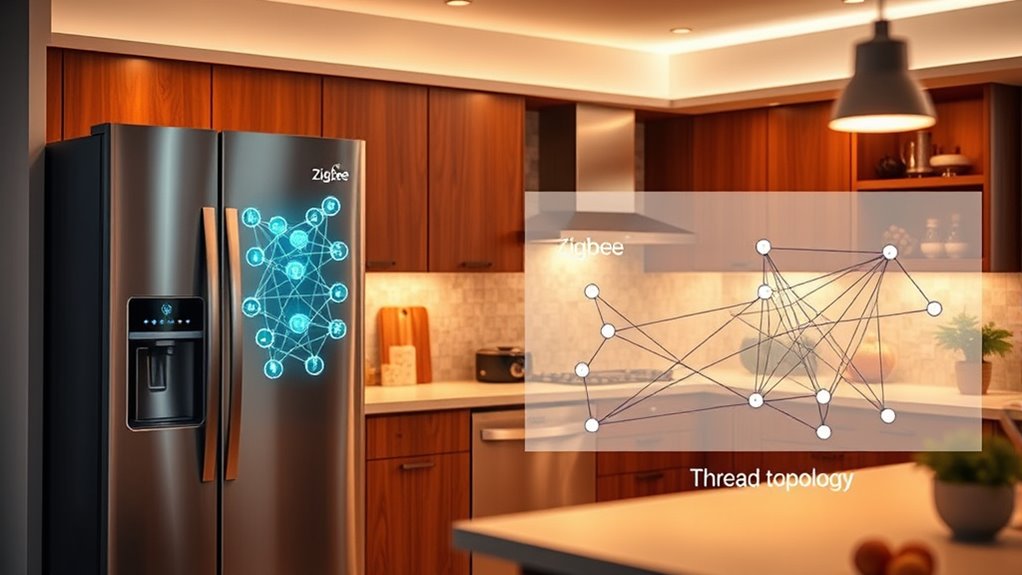
Zigbee and Thread each excel in different use cases based on their strengths and network capabilities. If you’re deploying smart home devices that require wide coverage and easy integration, Zigbee’s mesh networking makes it ideal for lighting, sensors, and remote controls. Its proven interoperability suits environments with multiple brands and devices. On the other hand, Thread is better suited for connected appliances that need low latency, high reliability, and secure communication, such as smart thermostats, door locks, or security systems. Thread’s IPv6 support and direct internet connectivity enable seamless integration with cloud services, making it perfect for appliances requiring frequent updates or remote control. Your choice depends on whether your focus is on broad device compatibility or high-performance, secure, and scalable appliance networks.
Frequently Asked Questions
How Do Zigbee and Thread Compare in Terms of Interoperability?
When comparing Zigbee and Thread regarding interoperability, you’ll find both aim to connect smart devices seamlessly. Zigbee has a broader ecosystem, so many devices from different brands work together easily. Thread, on the other hand, offers robust, low-power connectivity with better security and direct IP support, making it easier for devices to communicate across networks. Overall, Zigbee’s compatibility is more established, but Thread’s interoperability is growing rapidly.
Which Protocol Offers Better Support for Future Device Updates?
Imagine your smart appliances evolving seamlessly, like a garden blossoming with new blooms each season. When it comes to future updates, Thread offers a clear advantage. It’s designed with over-the-air firmware updates in mind, ensuring your devices stay current and secure. Zigbee, while reliable now, may require more effort for updates. So, for a future-proof setup that adapts and grows, Thread is your best bet.
Are There Any Regional Restrictions for Deploying Zigbee or Thread?
When considering regional restrictions for deploying Zigbee or Thread, you should check local regulations on wireless frequency use. Zigbee operates mainly in the 2.4 GHz band, which is widely available but may face restrictions in some countries. Thread also uses the 2.4 GHz spectrum, but local rules could limit its deployment. Always verify specific country guidelines to guarantee compliance before deploying these protocols in new regions.
How Do Network Latency and Response Times Differ Between the Two?
You’ll notice that network latency and response times vary between Zigbee and Thread. Zigbee often has slightly higher latency due to its mesh network structure, which can introduce delays during data transmission. Thread, on the other hand, offers faster response times because it’s built on IP technology, enabling more direct communication. Overall, Thread generally provides quicker, more reliable responses, making it better suited for time-sensitive connected appliance applications.
What Are the Long-Term Reliability Considerations for Each Protocol?
You might think reliability is straightforward, but long-term, both protocols have quirks. Zigbee’s mature ecosystem means widespread support, but it can face interference issues over time. Thread’s newer design promises robustness, yet its adoption isn’t universal. Ironically, your appliances’ longevity depends on your chosen protocol’s ability to adapt and grow. So, long-term, consider how each protocol evolves and maintains compatibility for future-proofing your smart home.
Conclusion
When choosing between Zigbee and Thread, consider how each network supports your connected appliances. Did you know that Zigbee can connect up to 65,000 devices, making it ideal for large setups? While Zigbee offers broad compatibility, Thread’s energy efficiency and simple mesh setup suit smart homes. Your choice depends on your needs for scalability, security, and ease of use—both are excellent options for creating a reliable, connected environment.
